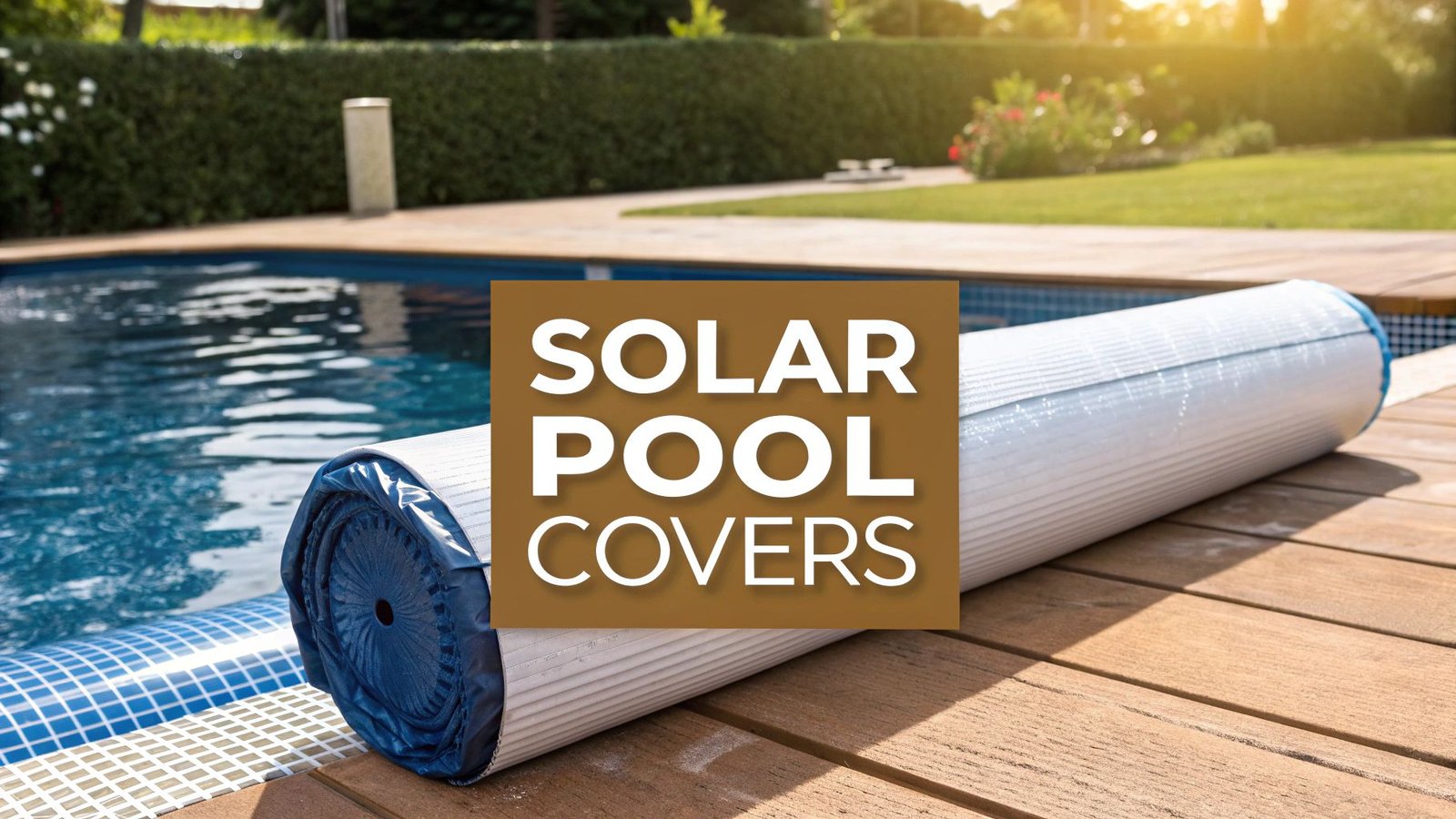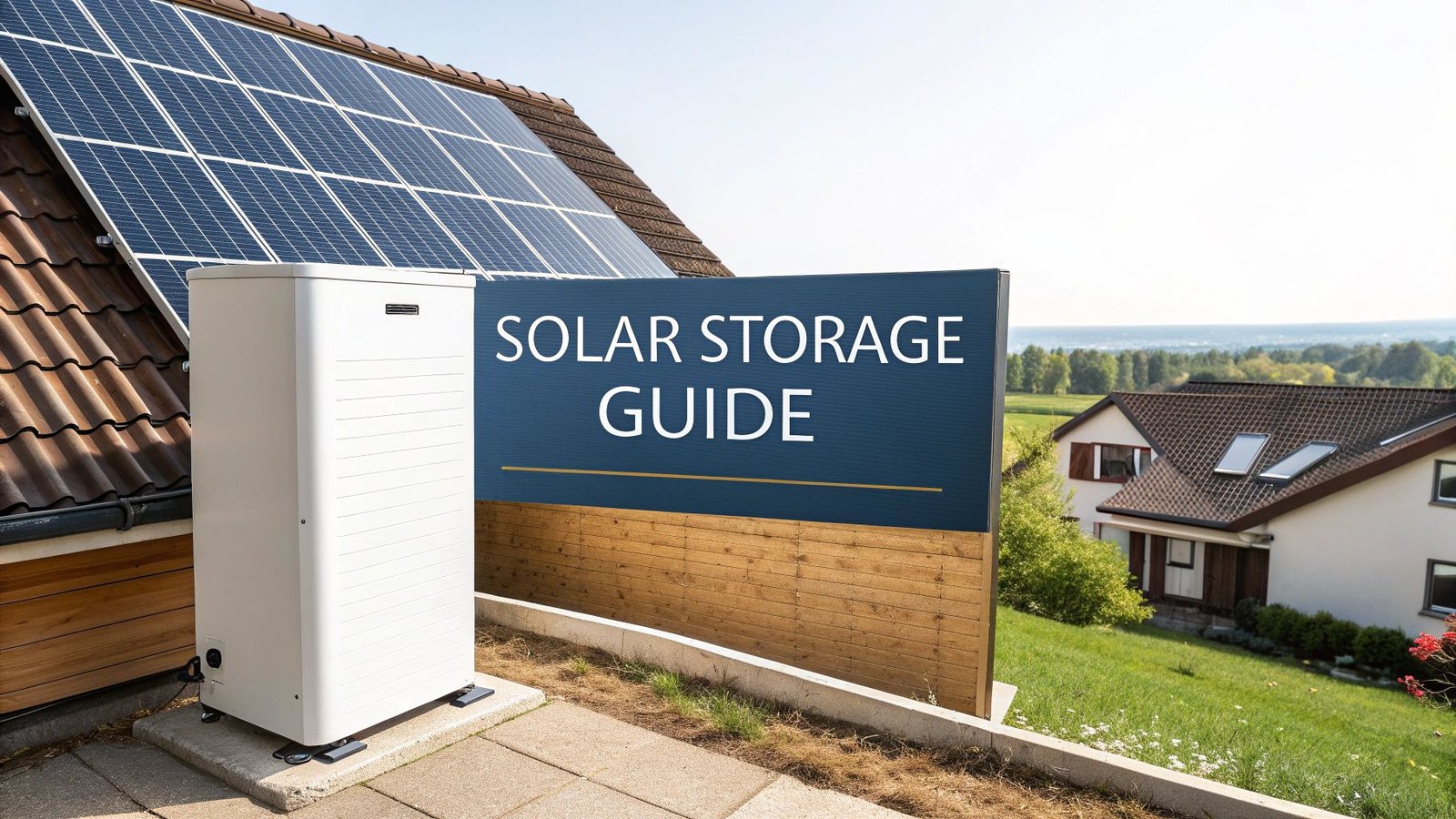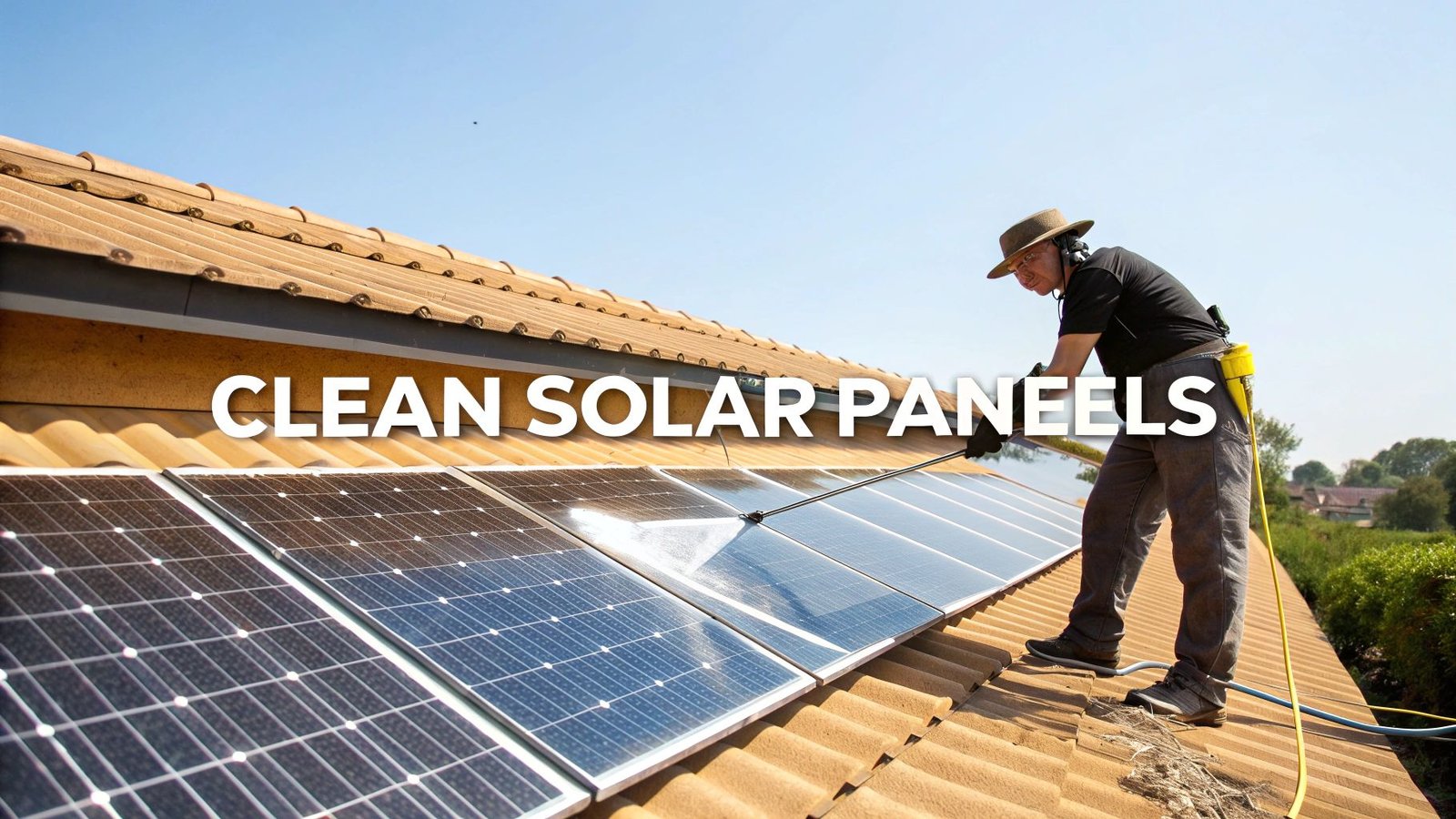Elegir la cubierta solar adecuada para su piscina no consiste sólo en comprar la primera que vea. Se trata de encontrar el equilibrio perfecto entre la calidad del material, su capacidad para mantener el calor y su durabilidad general. La mejor para usted se adaptará a su piscina como un guante, será lo bastante resistente para el clima local y no le costará un dineral.
Piense que no se trata de una simple lona, sino de una manta de alta tecnología que calienta activamente su piscina utilizando la energía gratuita del sol.
Guía rápida de cubiertas solares para piscinas
¿Qué es exactamente una cubierta solar para piscinas? Es una de las mejoras más sencillas y eficaces que puede hacer en su piscina. En esencia, se trata de una gran lámina de plástico especialmente tratado, salpicada de miles de diminutas burbujas de aire, que flota en la superficie del agua.
No se deje engañar por la sencillez de su diseño. Realiza dos tareas fundamentales a la vez: las burbujas atrapan la energía solar para calentar el agua, mientras que la propia cubierta actúa como un escudo, evitando que ese preciado calor -y el agua de su piscina- se desvanezca en el aire por evaporación.
La recompensa, tanto económica como medioambiental, es enorme. El mercado de todo tipo de cubiertas para piscinas $1.100 millones en 2024 y sigue subiendo, en gran parte porque la gente está viendo un retorno real de su inversión. ¿Cuánto? Los estudios han demostrado que una buena cubierta solar puede reducir los costes de calefacción de la piscina en la increíble cantidad de 1.000 millones de euros. 50% a 70%. Puede profundizar en el tendencias del mercado de cubiertas de piscina en verifiedmarketreports.com.
Principales ventajas de utilizar una cubierta solar para piscinas
Para apreciar realmente lo que aporta una cubierta solar, es útil ver las ventajas que ofrece. Cada ventaja se acumula, haciendo que la propiedad de la piscina sea más fácil, más barata y mucho más respetuosa con el medio ambiente. No se trata sólo de una piscina más cálida; se trata de una piscina más inteligente.
Lo que más cambia las cosas es cómo detiene la evaporación. Una piscina descubierta puede perder fácilmente cientos de litros de agua cada semana, llevándose consigo todos esos caros productos químicos. Una cubierta solar detiene 95% de esa pérdida.
Este sencillo cambio hace que el mantenimiento deje de ser una tarea constante para convertirse en una tarea mucho más manejable. Acabará ahorrando una cantidad sorprendente de tiempo, dinero y agua durante toda la temporada. He aquí un breve resumen de lo que puede esperar.
gráfico TD
A[Cubierta solar para piscinas] --> B(Ahorro de costes);
A --> C(Conservación del agua);
A --> D(Mantenimiento más fácil);
A --> E(Temporada de baño prolongada);
B --> B1("Menor gasto en energía y productos químicos");
C --> C1("Ahorra miles de litros");
D --> D1("Menos desnatado y aspirado");
E --> E1("Aumenta la temperatura del agua entre 10 y 15°F");
style A fill:#4285F4,stroke:#fff,stroke-width:2px,color:#fff
style B fill:#34A853,stroke:#fff,stroke-width:2px,color:#fff
estilo C fill:#34A853,stroke:#fff,stroke-width:2px,color:#fff
estilo D fill:#34A853,stroke:#fff,stroke-width:2px,color:#fff
estilo E fill:#34A853,stroke:#fff,stroke-width:2px,color:#fff
En resumen, una cubierta solar es un caballo de batalla que se amortiza solo, a menudo en la primera o segunda temporada. Es una solución sencilla a algunos de los mayores quebraderos de cabeza de tener una piscina.
Cómo atrapan y retienen el calor las cubiertas solares para piscinas
¿Alguna vez se ha preguntado cómo una simple lámina de plástico puede cambiar tanto la temperatura de su piscina? Todo se reduce a un ingenioso proceso de dos partes que funciona como un invernadero para el agua. Se trata de un concepto muy sencillo, pero su efecto es poderoso, ya que convierte la luz solar en un baño mucho más agradable.
Esta doble acción es el secreto de sus impresionantes resultados.
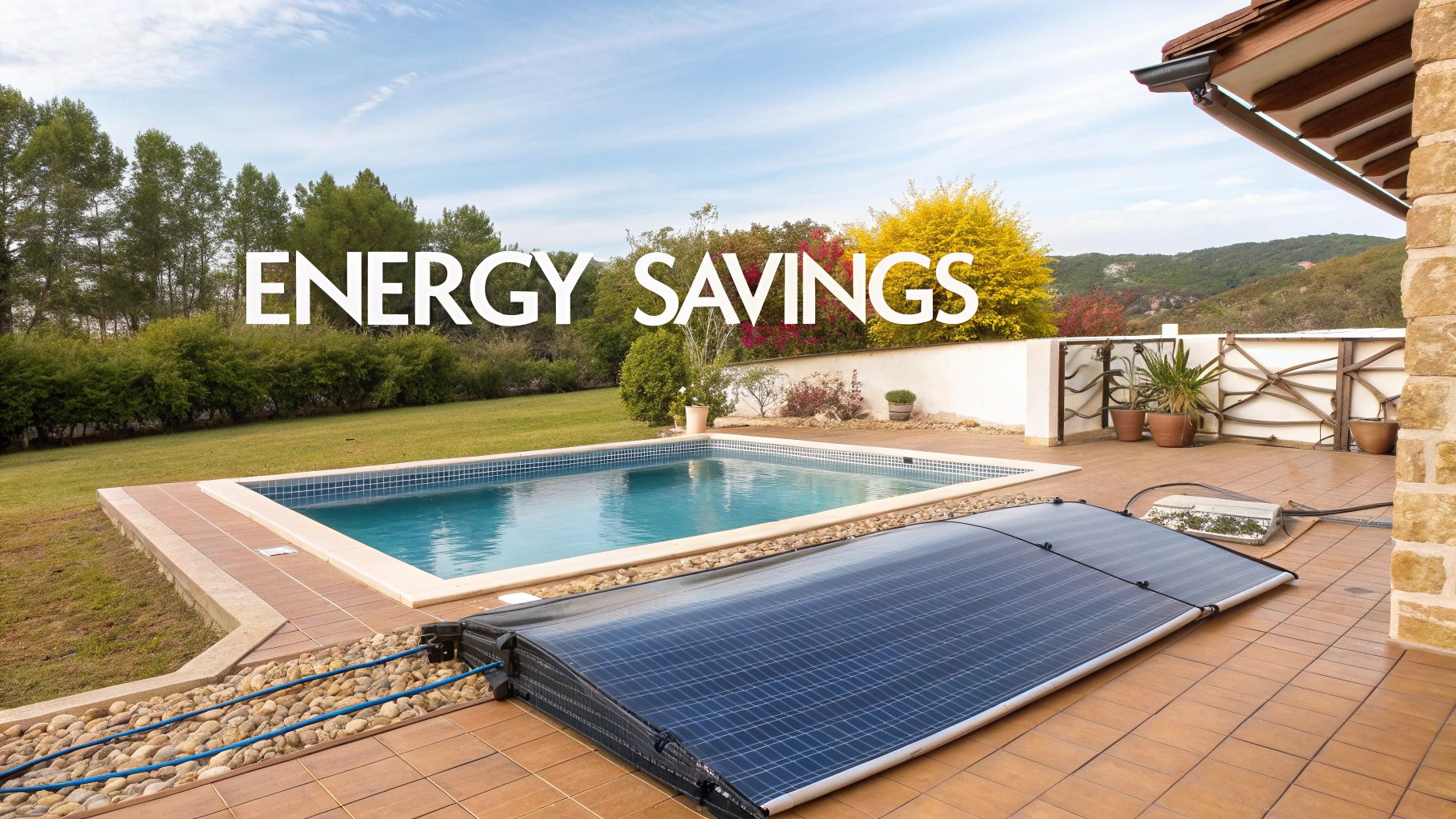
En primer lugar, hablemos del calentamiento. Esas miles de burbujitas de aire en la parte inferior de la tapa no están ahí sólo para ayudarla a flotar. Son como pequeñas lupas. Cuando los rayos del sol atraviesan el material translúcido, estas burbujas concentran la energía solar y transfieren el calor directamente al agua, aumentando la temperatura de forma constante durante todo el día.
El poder del aislamiento y la prevención de la evaporación
Por supuesto, generar todo ese calor no significa mucho si no se puede mantener. El principal responsable de que una piscina esté fría es la evaporación. 75% de su calor de esta manera.
Aquí es donde la segunda función de la cubierta, el aislamiento, resulta absolutamente fundamental. Al crear una barrera física en la superficie del agua, la cubierta reduce drásticamente la evaporación. Este efecto barrera es más importante durante la noche, cuando el aire frío intenta absorber todo el calor de la piscina. Una cubierta atrapa ese calor, garantizando que el agua siga siendo agradable a la mañana siguiente.
Esta combinación es la que marca la diferencia: calefacción activa durante el día y aislamiento pasivo las 24 horas del día. Esta combinación es lo que permite que una buena cubierta solar aumente la temperatura del agua hasta un 10-15°F.
Esta idea de gestionar la energía del sol es una estrategia inteligente utilizada en muchas soluciones para el hogar. Mientras que las cubiertas solares están diseñadas para atrapar el calor, otros productos como Persianas solares motorizadas para exteriores se construyen para bloquearlo, ofreciendo una forma flexible de controlar la exposición al sol y mantener cómodos los espacios exteriores.
Visualización de la diferencia de temperatura
Para ver realmente el impacto en acción, veamos cómo cambia la temperatura de una piscina en un ciclo típico de 24 horas. El siguiente gráfico muestra hasta qué punto puede cambiar las cosas una cubierta solar. No se trata de una pequeña diferencia, sino de un cambio fundamental: se pasa de una pérdida constante de calor a una retención significativa del mismo.
gantt
title Variación neta de la temperatura de la piscina en 24 horas
dateFormat x
axisFormat %H:%M
Sección con cubierta solar
Día (Ganancia de calor) : 0, 8
Noche (Pérdida de calor) : 8, -2
Cambio neto : 6, 0
Sección Sin Cubierta Solar
Día (Ganancia de calor) : 0, 4
Noche (Pérdida de calor) : 4, -7
Cambio neto : -3, 0
Como puede ver, el efecto neto es una piscina más caliente día tras día. De hecho, la piscina descubierta acaba más fría que al principio. Esta increíble eficiencia es la razón por la que una cubierta solar de calidad es una de las mejores inversiones que puede hacer para su piscina: puede prolongar la temporada de baño y a menudo se amortiza en un solo año en ahorro de energía.
Comparación de los distintos tipos de cubiertas solares
Cuando se empieza a comprar una cubierta solar para piscina, las opciones pueden parecer un poco mareantes. Pero en realidad todo se reduce a tres cosas: el material del que está hecha, su grosor y su color. Estos tres elementos son los que determinan lo bien que una cubierta calienta su piscina, cuánto tiempo va a durar y cómo se mantiene temporada tras temporada. El truco está en adaptar estas características al lugar donde vives y a lo que más necesitas.
Casi todas las cubiertas solares que encontrará están fabricadas con un plástico resistente de polietileno o vinilo, diseñado para soportar la exposición constante a los rayos UV y a los productos químicos de la piscina. Es una tecnología que se está imponiendo rápidamente. El mercado mundial de cubiertas solares para piscinas alcanzó los $2.500 millones en 2024 y va camino de alcanzar $3.800 millones para 2029. Este crecimiento muestra una clara tendencia hacia formas más inteligentes y energéticamente eficientes de disfrutar de nuestras piscinas.
Veamos los principales tipos de cubiertas solares que existen.

Como puede ver, las mayores diferencias se reducen al color y al material, y cada uno ofrece un conjunto único de ventajas.
Por qué es importante el grosor
El grosor de una cubierta, medido en "mils" (una milésima de pulgada), es probablemente el mejor indicador de su durabilidad y de lo bien que puede atrapar el calor. Puedes conseguir una cubierta más fina y económica, pero invertir en un poco más de grosor realmente compensa en rendimiento.
- 8-12 Mil: Estas fundas son ligeras y fáciles de manejar, pero no son las mejores para retener el calor y tienden a desgastarse más rápido. 1-3 años.
- 12-16 Mil: Para la mayoría de los propietarios de piscinas, éste es el punto ideal. A 16 milímetros por ejemplo, es mucho más duradera, evita mucho mejor la pérdida de calor durante la noche y puede durar más tiempo. 3-5 años o más si lo cuidas.
Si vives en una zona ventosa, una cubierta más gruesa es una obviedad. Ese peso adicional ayuda a mantenerla anclada en el agua en lugar de amontonada en un extremo de la piscina. Y si está buscando la solución de calefacción definitiva, merece la pena explorar completa sistemas solares de calefacción de piscinas que trabajan mano a mano con una cubierta de calidad.
Cómo afecta el color al rendimiento
El color es algo más que una elección estética: cambia fundamentalmente la forma en que la cubierta interactúa con el sol. Cada tono tiene una función distinta, por lo que debes elegir uno que se ajuste a tu objetivo principal, ya sea calentar el agua lo más rápido posible o mantenerla caliente toda la noche.
Piensa en ello como un intercambio. Las cubiertas transparentes son fantásticas porque permiten que la luz del sol penetre en el agua para calentarla más rápidamente. Por otro lado, las cubiertas más oscuras son las mejores para atrapar el calor y proteger el cloro del sol.
Para mayor claridad, comparemos las opciones más comunes.
Comparación de las características de las cubiertas solares
Esta tabla desglosa los pros y los contras de los tipos de cubiertas solares más populares para ayudarle a encontrar la que mejor se adapte a su piscina y a sus prioridades.
| Característica | Opción 1 (transparente, 12 mil) | Opción 2 (Azul, 16 mil) | Opción 3 (Era espacial, 14 milímetros) | Lo mejor para |
|---|---|---|---|---|
| Material | Polietileno transparente | Polietileno teñido de azul | Polietileno opaco con una capa inferior plateada reflectante | Todos están diseñados para resistir a los rayos UV y a los productos químicos. |
| Ganancia de calor | Excelente; deja pasar la mayor cantidad de sol para un calentamiento rápido y profundo. | Buena; equilibra la absorción de calor superficial con cierta penetración de la luz. | Muy buena; la capa superior oscura absorbe mucha energía solar. | Transparente para un calentamiento rápido; Space Age para una absorción eficaz. |
| Retención del calor | Regular; no aísla tan bien como las cubiertas más oscuras. | Bueno; mucho mejor que el transparente para evitar la pérdida de calor durante la noche. | Excelente; la parte inferior plateada refleja el calor en la piscina. | El diseño de la Era Espacial es el claro ganador en cuanto a aislamiento. |
| Ahorro químico | Pobre; los rayos UV lo atraviesan, descomponiendo el cloro rápidamente. | Bueno; bloquea una buena cantidad de rayos UV, ayudando a que el cloro dure más tiempo. | Excelente; proporciona la mejor protección contra los rayos UV, reduciendo el uso de productos químicos. | Propietarios de piscinas que desean reducir el consumo de cloro. |
Una vez sopesados estos factores -espesor, color y clima específico- podrá elegir una cubierta que no sólo funcione bien, sino que además le ofrezca la mejor relación calidad-precio.
Cómo elegir la cubierta solar adecuada
Elegir la cubierta solar adecuada no consiste en encontrar una solución mágica que sirva para todo. En realidad, se trata de adaptar la cubierta a su piscina, al clima local y a lo que está dispuesto a gastar. Si lo hace bien, convertirá el sol gratuito en una temporada de baño más larga y cómoda.
Todo comienza con el paso más básico, aunque el más crítico: es absolutamente necesario medir con precisión el tamaño y la forma de su piscina. Si tiene un rectángulo o un círculo sencillo, es fácil. Pero para piscinas en forma de riñón, en forma de L u otras formas libres, tendrá que medir los puntos más largos y más anchos. Así te asegurarás de que la cubierta que compres sea lo bastante grande como para recortarla y conseguir un ajuste perfecto y personalizado.
Alinear su elección con su clima
El lugar donde vive marca una gran diferencia. Por ejemplo, si vives en la soleada Arizona, es imprescindible que la cubierta sea resistente a los rayos UV para que no se estropee con el sol intenso. Por otro lado, alguien que viva en un clima más frío o septentrional debería buscar una cubierta diseñada para absorber y retener el calor al máximo.
Estas necesidades regionales son importantes a escala mundial. El mercado de cubiertas para piscinas crece de forma diferente en cada lugar del mundo, en función del clima y la economía locales. Por ejemplo, en Sudamérica, donde se prevé que el mercado pase de $115,9 millones en 2021 a $149,2 millones para 2025. Puede obtener más información sobre el mercado mundial de cubiertas para piscinas en cognitivemarketresearch.com.
Piense en su clima como el voto decisivo entre los distintos tipos de cubiertas. El sol intenso exige durabilidad y protección contra los rayos UV, mientras que las regiones más frías y nubladas necesitan toda la absorción de calor y aislamiento que puedan conseguir.
Equilibrio entre presupuesto y valor a largo plazo
Siempre es tentador optar por la opción más barata, pero hay que pensar en el valor a largo plazo. Una funda más gruesa, por ejemplo 16 milímetros costará más al principio, pero es casi seguro que superará y durará más que un endeble 8 milímetros cubierta. Así ahorrará en costes de sustitución. Una garantía sólida también es un gran signo de calidad: demuestra que el fabricante respalda su producto.
No olvide tener en cuenta sus costes energéticos totales. Invertir en una buena cubierta solar puede reducir considerablemente las facturas de calefacción, lo que se suma al ahorro de otras mejoras de eficiencia energética. Para hacerte una mejor idea de estos costes relacionados, consulta nuestra guía sobre la coste total de la instalación de un sistema de paneles solares.
Para facilitarle las cosas, repase esta sencilla lista de comprobación:
- Tamaño y forma de la piscina: ¿He medido mi piscina con precisión para garantizar una cobertura completa?
- Condiciones climáticas: ¿Intento sobre todo ganar calor, protegerme de los rayos UV o encontrar un buen equilibrio?
- Necesidades de durabilidad: ¿Hace viento en mi jardín? Si es así, probablemente necesite una cubierta más gruesa y pesada (12 milímetros o más).
- Garantía: ¿Viene la cubierta con al menos un 3 años de garantía ¿para estar tranquilo?
Si tiene en cuenta estos puntos clave, podrá elegir con confianza una cubierta que se adapte perfectamente, funcione a la perfección en su entorno específico y le proporcione un fantástico rendimiento de su inversión durante años.
Instalación y mantenimiento correctos
Ha hecho una inversión inteligente en una cubierta solar para piscina. Ahora vamos a asegurarnos de que la aprovecha al máximo. Un poco de atención a la instalación y un mantenimiento sencillo y regular harán que funcione eficientemente durante años, ahorrándole dinero y dándole más tiempo para disfrutar de su piscina.
Lo primero que tienes que hacer es ajustarla bien. La mayoría de las cubiertas tienen formas estándar, por lo que es casi seguro que tendrá que recortarla. No se trata sólo de una cuestión estética; una cubierta que se ajusta a la piscina como un guante crea el mejor sellado posible contra las paredes. Ese sellado es lo que retiene el calor y evita que el agua se evapore.
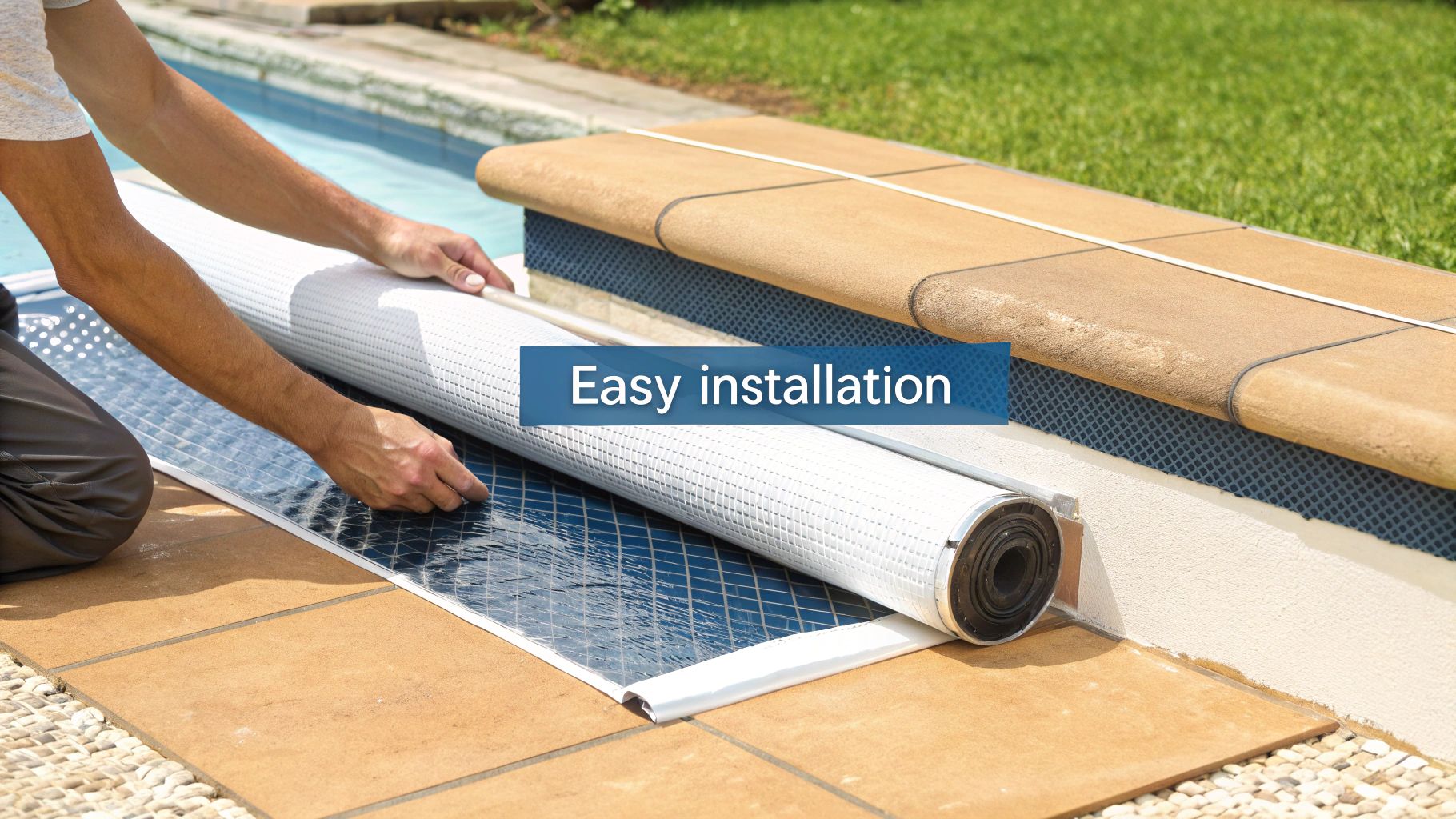
Cómo recortar la funda para un ajuste perfecto
Recortar una cubierta nueva es una tarea de bricolaje sencilla, pero no te precipites. Un poco de paciencia merece la pena en términos de rendimiento.
- Deja que se asiente: Desembala el cobertor y colócalo en la piscina, asegurándote de que la parte con burbujas esté orientada hacia el agua. Dale unas horas (o incluso un día entero) para que flote y se caliente. Así, los pliegues y arrugas del embalaje se relajarán y se aplanarán.
- Haz un corte aproximado: Coge unas tijeras afiladas o una navaja multiusos. Recorta alrededor del borde, pero deja 4-6 pulgadas de material extra alrededor. Esto le da un poco de margen de maniobra para el ajuste final.
- Márcalo: A continuación, rodee la piscina recortando con cuidado el sobrante a lo largo del borde del agua. La cubierta debe besar las paredes y flotar plana, sin enroscarse en los laterales.
Mantenimiento inteligente para que su cubierta dure
Una vez instalada la cubierta, unos cuantos buenos hábitos alargarán su vida útil de forma espectacular. El mejor accesorio que puede adquirir es un carrete de cubierta solar. Una sola persona puede poner y quitar la funda en un abrir y cerrar de ojos y, lo que es más importante, evita que se arrastre y se arrugue, lo que provoca roturas y desgarros.
Además, ten en cuenta estos sencillos consejos de mantenimiento:
- Manténgalo limpio: De vez en cuando, enjuaga bien la cubierta con la manguera de jardín para eliminar las hojas, el polen y la acumulación de productos químicos. Si la suciedad es persistente, basta con un cepillo suave y un poco de jabón neutro.
- Cuidado con los productos químicos: Cada vez que choque la piscina o añada una dosis importante de productos químicos, retire primero la cubierta. Lo mejor es dejarla quitada al menos 12-24 horas. Esto permite que los potentes productos químicos se mezclen con el agua y se ventilen, evitando que degraden el material de la cubierta.
- Guárdelo adecuadamente: Cuando acabe la temporada de baño, dale una última limpieza a la funda y déjala secar completamente. Luego, enróllala en su rollo o dóblala sin apretar. Guárdala en un lugar fresco y seco, al abrigo del sol, como un garaje o un cobertizo.
Almacenar la funda correctamente no es negociable. Si la dejas a la intemperie, el sol o el frío del invierno harán que el plástico se vuelva quebradizo y se rompa. Es el mismo principio que proteger cualquier otra inversión importante en el exterior. Por ejemplo, los propietarios de viviendas con paneles solares deben saber que cómo gestionar la nieve en los paneles solares para salvaguardar su sistema durante el invierno.
Preguntas frecuentes sobre cubiertas solares
Incluso con todos los detalles cubiertos, siempre surgen algunas preguntas. Y es normal. Vamos a abordar algunas de las preguntas más habituales de los propietarios de piscinas, para que pueda estar seguro de que está sacando el máximo partido a su nueva cubierta.
Piense en esto como una guía rápida para aclarar cualquier confusión final. Vamos a responder a estas preguntas.
¿Cuánto puede calentar mi piscina una cubierta solar?
Esta es la gran apuesta, y los resultados son bastante buenos. Una buena cubierta solar puede aumentar la temperatura de tu piscina en un 10 a 15 grados Fahrenheit (entre 5 y 8 grados centígrados). Normalmente, empezarás a notar la diferencia tras unos pocos días de sol.
Por supuesto, la temperatura exacta depende de factores como el tipo de cubierta elegida, la cantidad de sol directo que recibe la piscina y la temperatura del aire exterior. Funciona absorbiendo el calor, pero su verdadera magia consiste en detener la evaporación. La evaporación es el enemigo número uno de una piscina caliente, responsable de hasta 75% de todas las pérdidas de calor.
¿Las burbujas de una cubierta solar deben mirar hacia arriba o hacia abajo?
Se trata de un clásico error de novato, pero la respuesta es sencilla: las burbujas siempre boca abajoque no toque el agua. Esto no es sólo una recomendación, es esencial para que la cubierta cumpla su función.
He aquí por qué es tan importante:
- Transferencia de calor: Las burbujas actúan como pequeñas lupas que canalizan el calor del sol directamente hacia el agua.
- Aislamiento: Con las burbujas hacia abajo, una capa de aire queda atrapada entre la cubierta y el agua, actuando como una manta aislante. Esto es lo que mantiene la piscina caliente durante la noche.
Si lo pones con la burbuja hacia arriba, pierdes la mayor parte de las ventajas de calefacción y aislamiento.
¿Puedo utilizar el filtro de mi piscina con la cubierta solar puesta?
Sí, puede y debe hacerlo. La cubierta solar flota en la superficie, por lo que no estorba a los skimmers ni impide la circulación del agua.
De hecho, hacer funcionar la bomba con la cubierta puesta es bueno. Ayuda a mezclar el agua caliente de la superficie con el agua más fría de la parte inferior, lo que garantiza un calentamiento uniforme de toda la piscina. El único momento en que es realmente necesario quitarla es justo después de añadir determinados productos químicos, como un tratamiento de choque, para dejarlos "respirar" antes de volver a cubrir la piscina.
¿Cuánto suelen durar las cubiertas solares para piscinas?
Una cubierta solar puede durar desde De 3 a 5 años. La vida útil depende de varios factores: la calidad del material, su grosor (que se mide en milésimas de milímetro) y la exposición al sol y al cloro.
Una funda más gruesa, como un modelo de 12 o 16 milímetros con protección UV, casi siempre durará más que una fina y económica. Si la cuidas bien -por ejemplo, con una lámina protectora cuando está enrollada en un carrete- también puedes alargar su vida útil al protegerla del sol cuando no está en el agua.
Para que te hagas una mejor idea, esto es lo que puedes esperar en función del grosor.
gráfico TD
subgráfico 8-mil
A1("Vida útil: 1-3 años")
A2("Ligero y económico")
A3("Propenso a los rayos UV")
fin
subgráfica 12-mil
B1("Vida útil: 3-5 años")
B2("Buen equilibrio entre durabilidad y coste")
B3("El punto óptimo para la mayoría de las piscinas")
fin
subgráfica 16-mil
C1("Vida útil: 4-7 años")
C2("La opción más resistente, el mejor aislamiento")
C3("Excelente resistencia al desgaste")
fin
style 8-mil fill:#f9f,stroke:#333,stroke-width:2px
style 12-mil fill:#bbf,stroke:#333,stroke-width:2px
estilo 16 mil relleno:#9f9,trazo:#333,ancho trazo:2px
Elegir una gran cubierta solar para piscinas es un fantástico primer paso hacia una piscina más eficiente y agradable. Para los propietarios dispuestos a llevar la sostenibilidad al siguiente nivel, un sistema solar doméstico completo puede aportar una verdadera independencia energética. En Energía radiantediseñamos e instalamos sistemas solares de primer nivel para toda su vivienda. Más información sobre nuestras soluciones de energía solar y empiece hoy mismo a construir su futuro energético.

